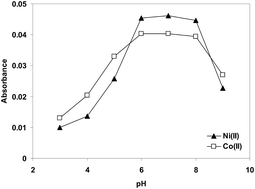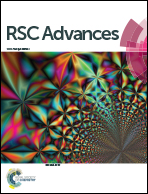Development of cloud-point extraction method for preconcentration of trace quantities of cobalt and nickel in water and food samples
Abstract
A new, efficient, and sensitive cloud point methodology was developed for preconcentration of trace quantities of cobalt and nickel in water and food samples prior to their determination by flame atomic absorption spectrometry (FAAS). The metals react with 2-(benzothiazolylazo)-4-nitrophenol (BTANP) at pH 7.0 and micelle-mediated extraction using the nonionic surfactant Triton X-114 medium. The surfactant-rich phase was diluted with acidified methanol and the cobalt and nickel content was determined by FAAS. The optimum conditions (e.g. pH, reagent and surfactant concentrations, temperature and centrifugation times) were evaluated and optimized. The proposed CPE method showed linear calibration within the ranges 5.0–100 and 5.0–150 ng mL−1 of cobalt and nickel, respectively, and the limits of detection of the method was 1.4 and 1.0 ng mL−1 of cobalt and nickel, respectively. The interference effect of some cations and anions was also studied. The method was applied to the determination of both metals in water and food samples with a recovery from the spiked water samples in the range of 95–102%. The validation of the procedure was carried out by analysis of a certified reference material.


 Please wait while we load your content...
Please wait while we load your content...